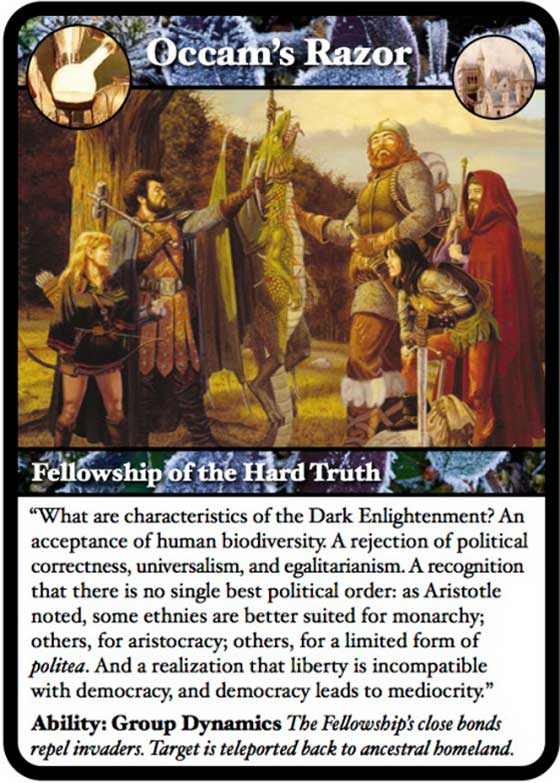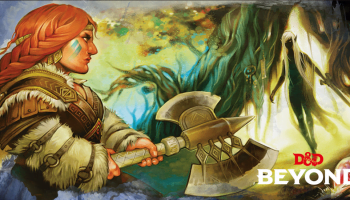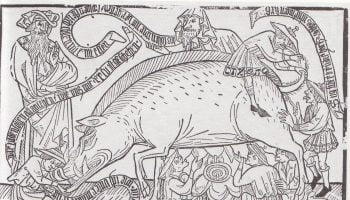This is Part I of The Public Medievalist’s continuing series on Race, Racism and the Middle Ages, written by one of our newest contributors, Amy S. Kaufman, a medieval studies professor and a scholar of the many disturbing abuses of the Middle Ages.
Read the Introduction to Our Series on Race, Racism, and the Middle Ages Here.
As a medieval studies professor, I try to free my students from the myth of “the Dark Ages.” Popular histories would have you believe that once the Renaissance came along—to steal a line from historian Judith Bennett— humanity “woke up, bathed, and stopped grievously oppressing women.” I remind students about the Renaissance witch trials, bloodshed between Catholics and Protestants, and the international slave trade. I point out that many things we consider barbaric, racist, and sexist sprang into being long after we left the so-called Dark Ages and saw the light.
But now that I know about the “Dark Enlightenment,” a sociopolitical theory that’s all the rage in white supremacist circles, I might hold back a little.
Anyone trawling the Internet to try to shed more light on the Dark Ages might stumble onto some disconcerting defenses of medieval times. You might, for instance, find yourself on the neo-Nazi Stormfront message board, where user “Fading Light” writes:
The “Dark Ages” is one of my pet peeves…”
—Hey, mine too, Fading Light!
“…brought up constantly by anti-Whites to bash our race…”
—Wait. What?
Fading Light goes on to brag, “I collect European achievements from that period as a hobby just to point out to people who believe in ‘Dark Ages’ how stupid they are.”
This is sort of like a medievalist’s wet dream turned into a nightmare: it turns out the same sites that promote links to “Top 10 reasons the Dark Ages were not dark” also post links to anti-Jewish conspiracy theories and flattering Hitler fan art. And one of their favorite things to link to, these days, is the Dark Enlightenment manifesto.
The Other Red Pill

“Dark Enlightenment” (DE) is a theory dreamed up by self-styled Internet philosophers who claim to trace modern-day problems to the end of the Middle Ages. According to DE proponents, the Enlightenment’s humanism, democracy, and quest for equality are responsible for the decay of Western civilization. DE gurus write long, self-aggrandizing online screeds that dabble in just enough science, philosophy, and political philosophy to be dangerous. They promise to “cure your brain” of Orwellian leftist propaganda by giving you a “golfball-sized red pill” that will “sear your throat like a live coal” (!)
Swallowing that massive rhetorical pill is supposed to urge the reader toward the following conclusions:
- Democracy leads to the zombie apocalypse.
DE manifestos sometimes use zombies as a metaphor for mediocrity, or sometimes for devouring each other in the name of capitalist self-advancement. And, once in a while, they actually seem to be talking about real zombies. What the West needs to save itself is a return to good, old-fashioned monarchy.
- Political correctness—by which DE means indulging in any pretense of human equality—is killing Western civilization.
As an ‘antidote’ to the poisonous infection of equality, DE manifestos posit an alternate theory they call “Human Biodiversity” (HBD). But while “Human Biodiversity” sounds like some kind of lovely futuristic plan for a colony in outer space, exploring the Dark Enlightenment subreddit will wipe that pleasant illusion away:
“Individual humans and human groups,” their page explains, “differ in ability, psychological disposition, intelligence, and other traits for genetic reasons. Genetics can explain 50% or more of the differences in lifetime outcomes within and between human groups. Other factors are minor by comparison.”
This, DE proponents argue, is not racism, but what they call “racial realism”: the idea is that biology and genetics endow us with different behavioral traits, and therefore we should all play different roles in the world.
“Racial realism” is, of course, a fantasy that has been thoroughly debunked by geneticists. If that 50% figure they quote sounds made up, that’s because it is. But interestingly, the attempt to separate ‘racialism’—attributing behavioral traits to different races based on biology, genealogy, geography, or environmental influences—from racism actually echoes a debate among medievalists held at the beginning of this century. Scholars asked: can we really talk about “racism” in a time before modern concepts of race existed? Some medieval white people believed that sin was associated with darker skin, but is that the same as “racism,” or was that technically religious discrimination? What about medieval adaptations of classical geographical theories, which posited that different climates invested the races with different strengths and weaknesses? Germans, according to Caesar, were tall and strong because they wore little clothing in cold environments and bathed in cold rivers; unsurprisingly, Caesar believes Romans like himself sprang from a climate perfectly conducive to martial and intellectual excellence.
Most medievalists have long since moved past the debate over terminology, which seems like rather dubious hair-splitting when even seemingly “neutral” racialisms impose hierarchies, usually with whiteness at the top. And white supremacy is the same conclusion Dark Enlightenment ‘thinkers’ draw when they use the Middle Ages to make their case.
The Usual Suspects

If you read posts by DE leaders like “Mencius Moldbug” or Nick Land, you would be forgiven for thinking that a Victorian social Darwinist has time-traveled into Silicon Valley. Like the Victorians before them, DEers fetishize the medieval West as the height of white greatness, a time when every race was in its proper geographical place, allowing white civilization to thrive in isolation. And like social Darwinists, they twist science, philosophy, and logic to rationalize what is, at its core, an emotional response: the fear of lost power and privilege in a globalizing, equalizing world.
Unsurprisingly, DE proponents also believe in biologically inevitable gender roles. As the DE subreddit claims:
“Recognition of HBD necessitates the rejection of the core progressive dogma of egalitarianism. Race and gender are not social constructs and everyone personally experiences that not all men or women are created equal. It is easier to believe in Leprechauns than to believe in egalitarianism.”

They share the “red pill” metaphor with the so-called Men’s Right’s movements as often as they share links to each other’s websites, and the Middle Ages do the heavy lifting for many of their gender theories. For instance Andrew Aglin, editor of the neo-Nazi news site Daily Stormer, made this statement on gender equality in 2015:
“My position on women, very explicitly, is that they should in the modern world remain in the exact same role they were in during the medieval period and I am unwilling to dance around or negotiate on that issue. Women should be honored, cherished and cared for, but they should not possess ‘rights.’”
‘Conventional’ white supremacists like Aglin butt heads with the Dark Enlightenment movement, and with the “alt right” in general. DE proponents did not begin as Nazis or fascists, and many still don’t want to be associated with them. DEers tend to be educated, well-off, technologically savvy atheists. They reject the Christian supremacy and Norse paganism typical in neo-Nazi circles.

Likewise, white supremacist groups often reject DE leaders even as they embrace their theories. Aglin, for instance, rejects DE as a movement because he claims white supremacists invented those ideas first—and, not incidentally, because one of DE’s founders is half-Jewish. (Side note: one of the really amusing things about all this infighting is the way that alt-righters and old school neo-Nazis accuse each other of being a Jewish conspiracy to make white supremacy look bad.) But none of these relatively minor disagreements change the fact that the “Dark Enlightenment” ideology is really just white supremacy dressed up in trendy glasses and a hoodie.
The Real History
DE’s grasp of medieval history is about as thin as its understanding of biology and geography. There was no such thing as the homogenous, insular medieval Europe they hope to resurrect. Al-Andalus, aka Muslim Spain, was right next to France. Parts of France were also England, and vice versa. The Vikings landed in all those places. Western European culture relied heavily on philosophical, literary, commercial, and scientific exchanges with people who were not white. And medieval women were scholars, religious authorities, healers, queens, merchants, and even military leaders and brewers.
But when a movement has so much online traction, especially among educated and highly-paid people, its “alternate facts” about the Middle Ages can’t be dismissed as sheer ignorance. Myths about the Middle Ages have a long history of being used to strip people of their rights: in the slaveholding American south, in 1930s Germany, and even now, under the neomedieval Islamic State. And this latest iteration of dangerous revisionist medievalism isn’t just popular in Silicon Valley: it may even have wormed its way into the White House.
No matter how rich, diverse, or interesting medievalists think the Middle Ages may have been, nobody wants our future to look like our past—especially if it’s the past that lives in the Dark Enlightenment imagination.
Continue to Part II: A Vile Love Affair: Right Wing Nationalism and the Middle Ages
The Public Medievalist does not pay to promote these articles, so we would love it if you shared this with your history-loving friends! Click to share with your friends on Facebook, or Twitter.





The “live coal” bit is probably a reference to Isaiah 6:6, no?
“My position on women, very explicitly, is that they should in the modern world remain in the exact same role they were in during the medieval period. …”
Cool. Eleanor of Aquitaine and I will be over here raising an army if you need us.